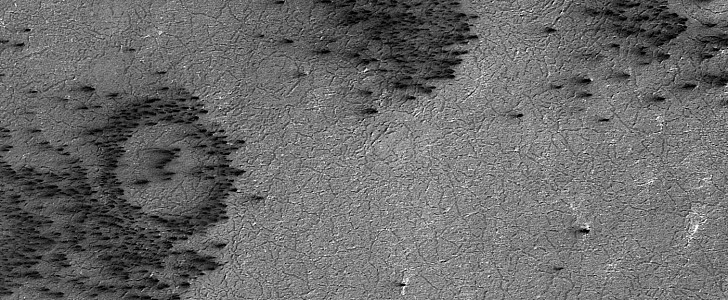The HiRISE orbital camera has proven to be an incredible resource for the humans looking to better understand the Red Planet. In orbit around Mars on board the Mars Reconnaissance Orbiter (MRO) ever since 2006, it has sent tens of thousands of photographs of the most interesting places on the planet.
And we're just getting to know some of them, as a while back we’ve started bringing under the spotlight the most interesting of these pics. We do it because, well, Mars is getting increased attention here on Earth, as it is the main target, alongside the Moon, for future crewed missions.
Aside for their habit of revealing perhaps little know things about Mars, these pics are spectacular in another sense as well: they almost always seem to show something that’s not real, as our brains try to make sense of the strangeness of the place.
The pic we chose for today, for instance, was snapped by HiRISE back in 2016, from an altitude of 249 km (155 miles), and was just made public by the University of Arizona, which runs the camera together with NASA.
It officially shows terrain “covered with a seasonal layer of dry ice.” Dry ice is the solid form of carbon dioxide, a substance abundantly present over there. There are tons of the stuff on this portion of Martian land, and for one reason or another it appears to the HiRISE camera as black.
These two features, under our brains' tendency to see familiar shapes patterns where there are none, give the impressions we’re looking at some massive, medieval and historically important battle between two armies of Martian ants, complete with specialized battle formations and tactics.
We’re not told exactly where on Mars this feature can be found, but scientists do say they tend to occur on crater rims, broken and pulverized by the impacts, where weak spots in the surface allow sublimating gas from beneath to escape.
Aside for their habit of revealing perhaps little know things about Mars, these pics are spectacular in another sense as well: they almost always seem to show something that’s not real, as our brains try to make sense of the strangeness of the place.
The pic we chose for today, for instance, was snapped by HiRISE back in 2016, from an altitude of 249 km (155 miles), and was just made public by the University of Arizona, which runs the camera together with NASA.
It officially shows terrain “covered with a seasonal layer of dry ice.” Dry ice is the solid form of carbon dioxide, a substance abundantly present over there. There are tons of the stuff on this portion of Martian land, and for one reason or another it appears to the HiRISE camera as black.
These two features, under our brains' tendency to see familiar shapes patterns where there are none, give the impressions we’re looking at some massive, medieval and historically important battle between two armies of Martian ants, complete with specialized battle formations and tactics.
We’re not told exactly where on Mars this feature can be found, but scientists do say they tend to occur on crater rims, broken and pulverized by the impacts, where weak spots in the surface allow sublimating gas from beneath to escape.








